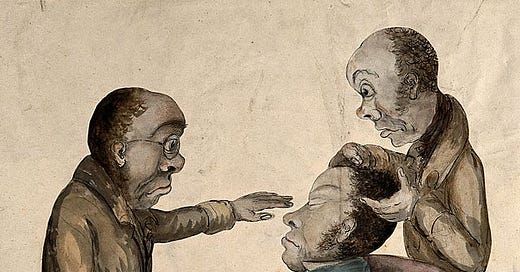FIVE MORE OF THE STRANGEST EVENTS IN THE HISTORY OF CRIMINAL PSYCHOLOGY
Bizarre incidents from around the world, featuring neuroscience, witchcraft, phrenology, bushrangers, robbery, gun battles, costumed crime-fighters, feminism, murder, and infanticide
1. ENGLAND Anne Greene is most important woman in the history of neuroscience whom most neuroscientists have never heard of. In 1650, Anne was hanged for the murder of a baby she had not known she was carrying: stillborn, poorly hidden, quickly discovered. Her execution was botched. She hanged for nearly thirty minutes before being cut down. The body was taken to the rooms of the Oxford anatomist, William Petty, who was planning an autopsy. When he opened the coffin, he discovered that Anne was still alive. One of the coffin bearers immediately stamped on her, trying to carry out the sentence that the hangman had failed to. Petty and his colleague, Thomas Willis, managed to stop him. Anne, literally, revived. They fed her (I’m not making this up) part of an Egyptian mummy that they’d ground up. It seems to have done her the power of good. The three of them together set up a small tourist business: people paid a tidy entrance fee to come to Petty’s room and see the miraculous woman lying in her coffin. Anne eventually took it home as a souvenir of her afterlife adventure. Petty and Willis, meanwhile, took the rights to her story, which they published in a pamphlet. It described Anne’s after-death experience which was…nothing. Her mind had stopped like a clock. Her mind, her spirit, her soul – all seemed made of flesh. That may not come as a surprise to you and me but to a seventeenth century concerned that scientists were making excursions into areas previously thought exclusive to the churchmen…well, it was the stuff of which bestsellers were made. The pamphlet was a sensation. The authors were spurred on to invent a new science which they called – what else? – ‘psycheology’.
2. AUSTRIA If you’d been travelling the roads of continental Europe in the early nineteenth century, you might have been surprised to encounter this ragtag troupe: two scientists, one servant, one wax modeller, a monkey, a pile of luggage, and more skulls than you’d have any immediate use for. Emperor Francis I of Austria had been unimpressed by these scientists, named Franz-Joseph Gall and Johann Spurzheim. In the picture below, you can see them examining a patient. They’d been busy teaching Austrian civilians to run their fingers over other people’s heads and work out what was inside. Their science was called ‘phrenology’. It was a forerunner of modern psychology. Emperor Francis did not want his subjects to get too enthusiastic about this blasphemous new fad, which seemed to allow them to venture where only God ought to go. Accordingly, he threw the phrenologists out of his country. By all accounts, Gall and Spurzheim had a merry old time of it. They visited fifty different cities and entertained the majority of the reigning kings and queens of Europe. They even dropped in at the occasional prison, where Gall amazed the warders with his ability to tell which convicts had committed which crimes – all by touching their heads. On one occasion, he discovered a woman, dressed exactly like the others, but lacking a prominent ‘organ of theft’ on her skull. ‘For what reason is this woman here?’ Gall demanded. ‘For her head announces no propensity to theft’. The answer: ‘She is the inspectress of this room’. When his entourage reached Paris, Gall decided to settle down. He remained there until his death in 1828.
3. AUSTRALIA There is a lot of discussion in psychology about multiple personality disorder (now known as dissociative identity disorder). We’re not about to get into the technicalities here. John Douglas, the well-known offender profiler, has argued that the disorder seems never to make one ‘personality’ violent while rendering the other, non-violent ‘personality’ incapable of restraining it. One possible counterexample, though, is that of Andrew George Scott. Now, Andrew Scott is a pretty good name (there’s certainly nothing wrong with it) but if I had a choice over introducing myself as Andrew Scott or Captain Moonlite, I know which one I’d choose. Scott was the son of a clergyman, born in Ireland, who emigrated at a young age to the other side of the world. He was known as a well-educated, polite, cultured preacher who was kind enough to do unpaid engineering work on the side. Captain Moonlite, though, was altogether different. In May 1869, he put on a mask and walked into the Union Bank. The manager took one look at him and said, ‘This is no time for jokes, preacher’. But Moonlite stole £1000 in cash and gold and rode off. The manager and a local schooloteacher were arrested. No one believed Scott could possibly be a villain. Captain Moonlite next appeared in 1871. Arrested for another roobery, he escaped from a ‘escape-proof’ gaol by making a human ladder with other prisoners. He was recaptured a week later and forced to spend another seven years inside. Freed, Scott moved to Sydney. There, he used a rubber cheque to buy a yacht for a South Sea Islands cruise. The police caught him with stolen gold in his pocket. This time he was a model prisoner. On release he made a lecture tour, telling youngsters about the folly of crime. It looked as though Scott had won the upper hand over his alter ego…at least until the day he and five other bushrangers captured the marvellously-named Wantabadgery station on the Murrumbidgee River. He forced his prisoners to whip up a fancy dinner, during which he entertained them with long speeches and bloodthirsty threats. Police began firing at the Station. Not wanting to see them shot, merciful Moonlite let fifty prisoners go. The exciting gun-battle lasted two hours before the bushrangers escaped. Oddly, they stopped off to buy brandy and milk. The police caught up. One officer was killed before Moonlite was recaptured. At the trial, Andrew Scott was back in charge. He made a moving speech on behalf of his young companions: ‘If the law has been so broken that it must be avenged by a human life, then let me be the victim and spare these youths. God created them for something better than the gallows’. The jury found the defendants unanimously guilty but recommended mercy for all except Scott.
4. UNITED STATES Psychologists haved had a tangled relationship with costumed crime-fighters. It was a psychologist – Frederic Wertham – who wrote the notorious book, Seduction of the Innocent, which primed the censorious pumps of the Comics Code Authority, indiscriminate wrecker of superhero, crime, and horror comics for several decades. Another contribution, though, could have come only from the polyamorous pen of an academic who was as interested in feminism as he was in lie-detection, published a number of books of popular psychology, and may remain the only psychologist ever to be inducted into the Comic Book Hall of Fame. Elizabeth Holloway Marston suggested to her husband, William, that her blood pressure seemed to go up whenever she told a lie. Rather than asking her exactly what she’d been lying about, Marston decided to create his own systolic blood pressure test. Later it became a component of the polygraph, the supposed ‘lie detector’ which is still in use today. Not that the couple can have had too many secrets from each other: they shared a mutual lover called Olive Byrne, who was also one of Marston’s students. Marston wrote about the educational potential of comicbooks in one of his articles. It was entitled ‘Don’t Laugh at the Comics’ and appeared in Family Circle, no less. Soon he took a job at DC-National. Here, Marston ‘set out to redress the all-male domination of the world of superheroes’. Indeed, the character he created – originally called Suprema - was a model for liberated mid-century women throughout the Anglosphere. Suprema was a denizen of a timeless female utopia who nevertheless became an agent for the US government during the Second World War. Embodying the dreams of little girls everywhere, she was as tough and independent as any man of the time but also in constant contact with her mother (who, creepily, could see her at all times through a magic mirror). She was kinda kinky, too, forever tying people up and encouraging light S&M. Not just that – the magic lasso she carried forced her enemies to tell the truth, the whole truth, and nothing but the truth (if only the polygraph had been half so successful). It was a long way from what Marston called the ‘bloood-curdling masculinity’ of other superhero comic books. Marston died young, just 54. By that time, his creation had been called by her new name for six years: Wonder Woman.
5. CANADA On 23rd May, 1987, in the middle of the night, Kenneth Parks rose out of bed, started up his car, and drove fourteen miles to his in-laws’ house. He let himself inside, beat his mother-in-law to death, and choked his father-in-law, who survived. Some time later, Parks turned up at a local police station, confessing that he thought he’d murdered someone. Interviewed seven times, Parks insisted that he remembered nothing. At trial, despite all the evidence against him, Parks was found not guilty. His defence was that he’d been asleep the whole time. This is perhaps the most striking example in the literature of a phenomenon now known as somnambulistic homicide. There are other examples. In 1859, one Esther Griggs threw one of her babies out of the window while shouting, ‘Save my children!’ At trial, the defence claimed that she’d been dreaming her house was on fire. Like Kenneth Parks, she was found not guilty. In 1878, Simon Fraser killed one of his children by smashing his head on the ground, all the while dreaming that he was killing a wild animal that was menacing his family. His punishment? – he was made to sleep alone in a locked room for the rest of his nights. ‘Local sleep’ is the name of the psychological phenomenon. Parts of the brain associated with movement, emotion, and vision, remain switched on while the rest of the brain sleeps. Related to somnambulistic homicide is sexsomnia. It is exactly what it sounds like and sometimes causes exactly the crime you are thinking of.
Please click a button, or buy me a coffee, or both!
All pictures courtesy of WikiMedia Commons.








